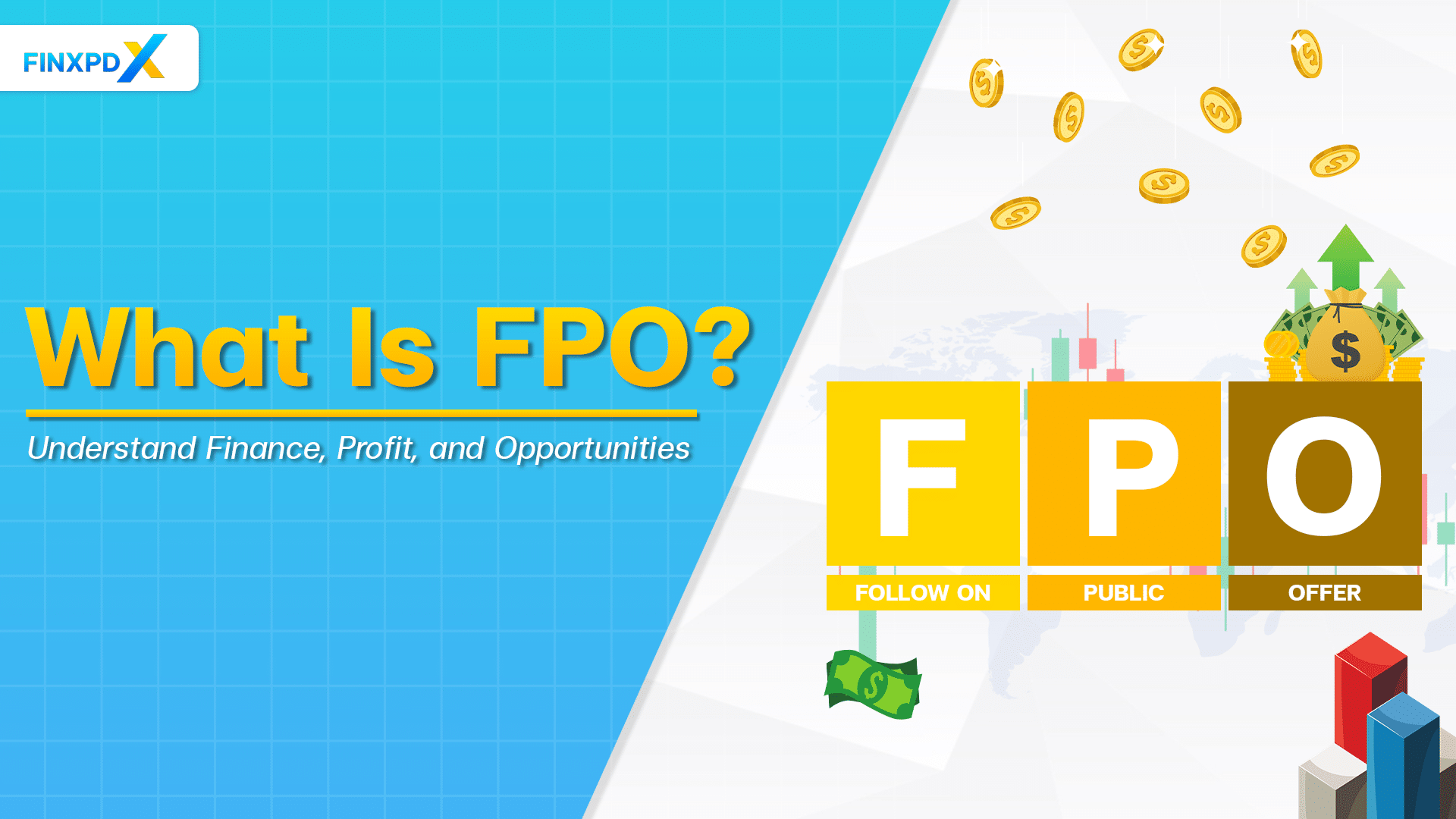In the financial world, follow-on public offerings (FPOs) are really important for raising funds. Many investors and people studying the stock market are interested in understanding FPO better. This article will make it easier for traders at all levels.
We will cover what FPO means in the stock market, including its different types, like dilutive FPO (which means more shares are added) and non-dilutive FPO (no new shares). We will also examine how FPOs differ from initial public offerings (IPOs). This article will help you understand the unique things about each type and how companies raise money through shares.
What Is FPO?
FPO or follow-on public offering, is a term frequently encountered in financial processes, particularly when discussing stock market strategies. An FPO allows a publicly listed company to issue additional shares to strengthen its equity capital.
Unlike an IPO (initial public offering), which marks a company’s debut in the public market, an FPO is undertaken by companies already public and trading on a stock exchange. This method is an effective capital-raising strategy, enabling these firms to expand their financial resources. An FPO represents a secondary offering, distinct from an IPO, for companies seeking further investment influx by issuing new stocks in the financial market.
Key Takeaways
- FPO full form( Follow-on Public Offering) is a method used by publicly traded companies to raise additional capital by issuing more shares.
- FPO can be categorized primarily into two types: rights issues and public issues, each with its own set of rules and advantages.
- Companies initiate FPO to raise capital for specific needs like business expansion or debt reduction.
- While IPOs are for companies going public for the first time, FPOs are for already publicly-traded companies looking to issue additional shares.
How Does FPO Full Form in Share Market Work?
A follow-on public offering (FPO) is a refined financial tool designed for companies already trading in the public market. It’s a strategic move used to secure additional capital. Typically, the need for an FPO arises when a company identifies a significant requirement for more funds, which could be for various reasons. These reasons include reducing debt levels to improve financial stability, financing major business expansions, supporting new projects, or seizing new market opportunities requiring substantial investment.
When a company decides an FPO is the right step, it initiates a process that involves issuing new shares to the public. This process is planned and executed, often involving investment bankers, legal teams, and marketing efforts to ensure a successful offering. After the completion of the FPO, the raised capital is allocated to the previously identified needs. This could be anything from launching a new product line to entering a new market or upgrading existing operational facilities.
Investors must understand the implications of an FPO because the issuance of new shares can dilute the value of existing shares. This means that while the company may gain additional capital, each existing share represents a slightly smaller ownership percentage of the company. Eventually, this dilution effect is a key consideration for shareholders as it can influence the share price and their overall investment in the company.
Types of FPO
Understanding the different types of follow-on public offerings (FPOs) is necessary for both companies aiming to raise capital and investors looking to make smart choices in the stock market. This part focuses on 2 primary types, each with its unique characteristics and implications:
1. Rights Issue
This is a type of FPO where the company offers new shares to existing shareholders at a discounted price, usually proportional to their existing holdings. It’s a way to raise capital while allowing current shareholders to increase their investment before the shares are offered to the public.
2. Public Issue
Contrasting with a rights issue, a public issue FPO involves offering new shares directly to the public, not just existing shareholders. This method is more open and can attract a broader range of investors, but it also means existing shareholders might see their ownership percentage decrease if they don’t participate.
5 Benefits of Using FPO
Follow-on public offerings (FPOs) serve as an effective avenue for companies looking to garner additional funds. Here are the benefits :
1. Capital for Expansion or Debt Reduction
When companies need extra funds, FPOs are a common choice. The money raised can help in many ways, like growing the business, opening a new location, or developing new products. It’s also useful for paying off debts, which improves the company’s financial health and makes it more attractive to new investors.
2. Shareholder Loyalty
In rights-issue FPOs, current shareholders can buy new shares first. This approach shows the company values its existing investors, strengthening their trust and connection with the company. It’s a way of expressing gratitude to those who have already invested and encouraging them to stay involved.
3. Market Confidence
A successful FPO often improves the company’s identity from the perspective of the market. This boost in reputation can lead to an increase in the stock’s value over time, reflecting the company’s growing potential and stability.
4. Liquidity
After increasing liquidity, it’s usually easier to buy or sell the company’s shares after an FPO. This means investors can move their money in or out more freely, which is a big advantage for those looking to manage their portfolios actively.
5. Diversification
An FPO allows investors to add more variety to their portfolios. It’s an opportunity to buy more shares without hassle, helping them spread their investments across different assets.
What Are the Differences Between FPO and IPO?
Follow-on public offerings (FPOs) and initial public offerings (IPOs) are both ways for companies to raise capital by issuing shares, but they’re not the same. To clarify these differences, we’ll look at each in detail, contrasting their unique features.
| Feature | FPO | IPO |
|---|---|---|
| Purpose | To raise additional capital after going public | To go public and raise initial capital |
| Audience | Both new and existing shareholders | Primarily new shareholders |
| Pricing | Market-driven or predetermined | Often determined by underwriters |
| Regulatory Scrutiny | Generally less stringent | More rigorous due to being the first public offering |
| Share Dilution | Typically dilutes value of existing shares | No existing shares to dilute |
| Complexity | Generally simpler | Usually involves more complexity and steps |
Conclusion
FPO full form “ follow-on public offerings ” are an essential tool for publicly-traded companies. They allow these companies to raise extra capital. In contrast, an initial public offering (IPO) helps a private company go public for the first time. Each option has its own advantages and complexities.
For companies, FPOs are a more straightforward way to get additional funding. However, they can dilute the value of existing shares. For investors, it offer a chance to deepen ties with a known company. Benefits range from shareholder loyalty to market confidence. Whether you’re a company or an investor, understanding this can give you an advantage and help you make smarter financial decisions.
FAQs
FPO full form “follow-on public offering”, is a way for already publicly-traded companies to raise more capital. They do this by issuing additional shares in the stock market. These new shares can be offered to current shareholders or new investors, depending on the type of FPO.
It comes with some drawbacks. The main one is the dilution of share value for existing shareholders. Additional shares in the market can lead to a decrease in the value of each share. Another disadvantage is that conducting an FPO requires resources and may involve regulatory complexities.
Investors often see it as less risky compared to IPOs. This is because the company is already publicly-traded, and its performance data is available for review. However, the potential for high returns might be lower in FPOs, as they are generally considered to be less volatile than IPOs.
Not all companies can conduct an FPO. Generally, the company must be already publicly traded. It also needs to meet certain regulatory requirements and financial conditions to be eligible for an FPO. These conditions can include things like minimum profitability and compliance with corporate governance norms.
Related Articles:
- IPO Stock Trading: A Better Choice for Investment
- P/E Ratio: A Crucial Thing for Stock Analysis
- What Is After-Hours Trading? Learn How It Works
Read more: Stocks








